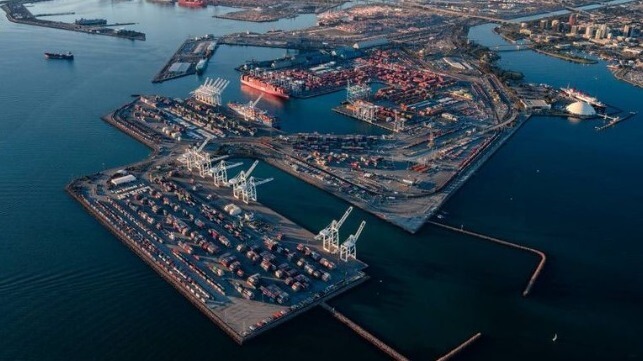Exports Rise as SoCal Ports Record Overall Drop in Container Volumes

Container volumes at the Southern California ports, the busiest in the nation with long backlogs a year ago, fell significantly in September. Both the Port of Los Angeles and the Port of Long Beach are now predicting a continuing easing in volumes in what normally would have been a peak season for the ports. The mounting declines come after a two-year record run in volumes often setting monthly records at both ports.
“Consumers and retailers are concerned about inflation, leading to warehouses filled with inventory and fewer product orders from Asia,” said Port of Long Beach Executive Director Mario Cordero yesterday describing his port’s activity in September. “The respite is leading to increased capacity on the docks and fewer ships waiting off the coast to enter the port.”
Port of Los Angeles Executive Director Gene Seroka echoed a similar sentiment during today’s media briefing on his port’s activity in September. After 25 months of record-breaking import volumes, Seroka said that September continued the declines at began in August 2022. He confirmed that the declines are coming from nearly all the port’s activity.
The one positive note in the broader downturn came from exports, which for example at the Port of Los Angeles had been down in 39 of the last 47 months. Both Los Angeles and Long Beach reported that exports were up by approximately two percent in September. Los Angeles handled just under 78,000 TEU of exports, up 2.5 percent, while Long Beach handled just under 113,000 TEU of loaded exports, up 1.9 percent.
The declines came mostly from the import volumes at both ports. For Los Angeles, imports were down 26.5 percent in September to under 344,000 TEU. Similarly in Long Beach, imports decreased 7.4 percent to just under 343,000 TEU. This led to an overall 21.5 percent decline in volumes at Los Angeles (just under 710,000 TEU) while overall volume was down around one percent in Long Beach (just under 742,000 TEU).
The declines in volumes are more significant when compared to the five-year averages. The Port of Los Angeles reported that monthly volume was down 14 percent below its five-year average. Imports were down more significantly at 20 percent below the five-year average.
Executives at both ports highlighted several factors that they believe are contributing to the declines. They pointed out that retailers had advanced shipments with the peak volumes coming in June and July and meaning that many already have full warehouses. Further, as consumers are growing more cautious, retailers appear to have slowed their imports.
Los Angeles said parts and components also make up a nearly equal portion of the volumes moving through the port. They, however, highlighted the increase in volumes to the U.S. Gulf and East Coast ports as shippers and carriers changed ports due to concern over the ongoing West Coast labor negotiations.
The outlook remains for decreased volumes which are also reflected in a decline in the number of containers backlogged at the ports and the containers on dock for nine or more days. The Marine Exchange of Southern California highlights that just four containerships are registered in its traffic management system as of October 19 heading to the ports down from the over 100 vessels a year ago. Overall, the port of Los Angeles reports there are 35 ships currently inbound for the San Pedro Bay ports down from a number typically in the 40s.
“Despite what will likely be a soft ending to 2022, we are on track to have the second-best year in our history,” said Seroka. “More importantly, the cargo backlog that began last year has been nearly eliminated due to the diligent, combined efforts of our supply chain partners.”
Overall, the ports continue to report strong traffic for the year, expecting solid volumes for 2022. Long Beach at the end of the first nine months had handled more than 7.3 million TEU, which is up 3.5 percent from 2021. The Port of Los Angeles has processed nearly 7.9 million TEU during the first nine months of 2022, which while down about four percent from last year’s record pace, still has the port on track for its second busiest year. Seroka points out that if they remain above 700,000 TEU in each of the last three months, the port will again reach the 10 million TEU mark.
